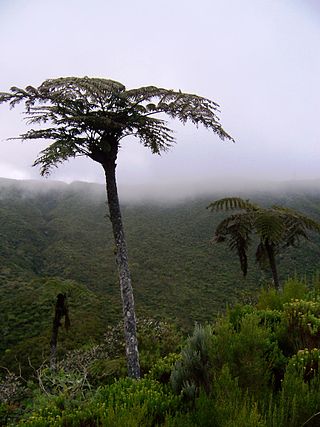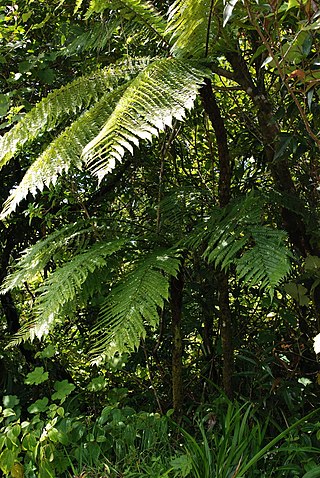
Sphaeropteris cooperi, synonym Cyathea cooperi, also known as lacy tree fern, scaly tree fern, or Cooper's tree fern, is a tree fern native to Australia, in New South Wales and Queensland.

The Cyatheaceae are a family of ferns, the scaly tree ferns, one of eight families in the order Cyatheales in the Pteridophyte Phylogeny Group classification of 2016. Alternatively, the family may defined much more broadly as the only family in the Cyatheales, with the PPG I family treated as the subfamily Cyatheoideae. The narrower circumscription is used in this article.

Sphaeropteris is a genus of tree ferns in the family Cyatheaceae. It has been treated as a subgenus within the genus Cyathea, but is accepted in the Pteridophyte Phylogeny Group classification of 2016.
Alsophila albidosquamata, synonyms Cyathea albidosquamata and Sphaeropteris albidosquamata, is a species of tree fern native to the Maluku Islands, New Guinea and the Bismarck Archipelago, where it grows in rain forest and montane forest at an altitude of 620–2,500 m (2,000–8,200 ft). The trunk is erect and about 2 m tall. Fronds are bi- or tripinnate and 1–1.5 m in length. The lower surface of the rachis is covered in scales and the stipe has scattered scales throughout its length. These are glossy and pale, with dull, fragile edges. Sori occur near the fertile pinnule midvein and have flat indusia which resemble small saucers.

Alsophila australis, synonym Cyathea australis, also known as the rough tree fern, is a species of tree fern native to southeastern Queensland, New South Wales and southern Victoria in Australia, as well as Tasmania and Norfolk Island.
Gymnosphaera biformis, synonyms Alsophila biformis and Cyathea biformis, is a species of tree fern native to New Guinea and the Maluku Islands, where it grows against trees in mossy forest and rain forest at elevations of 850–2200 m. The climbing trunk is very thin, only 1–2 cm in diameter, but can reach 3 m in height. The apex of the trunk is covered in scales. Two types of fronds are produced, simple pinnate fronds, which are sterile, and bipinnate fronds, which may be fertile. The stipe is smooth, glossy and very dark, almost to the point of being black. It is covered at the base with long, very dark scales that have a pale margin. Fertile pinnules are distinctly stalked and lobed. Sori occur in four pairs per pinnule lobe and lack indusia.
Alsophila brooksii, synonym Cyathea brooksii, is a species of tree fern native to Cuba, Hispaniola and Puerto Rico, where it grows on serpentine soils in shaded ravines, along streams, and on forested slopes at an altitude of 250–950 m. The trunk is prostrate and only about 6 cm in diameter. Fronds are pinnate or bipinnate and up to 2 m long. The base of the rachis is covered with blackish scales that have a paler margin. Sori occur in two rows, one along each side of the pinnule midvein.
Alsophila buennemeijeri, synonym Cyathea buennemeijeri, is a species of tree fern endemic to the Natuna Islands in Indonesia. In the World Geographical Scheme for Recording Plant Distributions, these islands are treated as part of Kalimantan. A. buennemeijeri grows in open scrub at an altitude of about 600 m. This rare species is known only from the summits of two low hills. The trunk is erect and may be 5 m tall or more. Fronds are bi- or tripinnate and 2–3 m long. The stipe is dark and covered with spines at the base, as well as numerous scattered dark scales with pale, fragile edges. Sori occur near the midvein of fertile pinnules and are covered by thin, fragile indusia that resemble cups in shape.
Alsophila caudata, synonym Cyathea caudata, is a species of tree fern native to the islands of Luzon and Mindanao in the Philippines, where it grows in montane forest. The trunk is erect and up to 4 m tall or more. Fronds are bi- or tripinnate and 1–2 m long. The stipe is warty and covered with dark, narrow, glossy scales. Sori are borne near the midvein of fertile pinnules and are protected by firm, brown indusia. As of April 2022, Plants of the World Online treated it as a synonym of Alsophila speciosa.
Alsophila hermannii, synonym Cyathea christiiCopel., is a species of tree fern endemic to Mindanao in the Philippines, where it grows in forest at an altitude of 900–1800 m. The trunk is erect and may be 5 m tall or more. Fronds are bi- or tripinnate and 2–3 m long. The stipe is covered with some warts and narrow, brown scales. Sori occur near the midvein of fertile pinnules and are covered by thin, fragile indusia.

Alsophila dregei, synonym Cyathea dregei, is a widespread species of tree fern in southern Africa.
Alsophila dryopteroides, synonym Cyathea dryopteroides, is a tree fern native to Puerto Rico, where it grows in shaded areas and cloud forests at an altitude of 1000–1200 m. The erect trunk may be 1.3 m tall and approximately 5 cm in diameter. Fronds are pinnate and up to 1.6 m long. The rachis is often purplish brown and covered with scales, usually on the underside. The scales range in colour from golden brown to bicoloured. Sori occur along each side of the pinnule midvein and indusia are cup-like.
Alsophila exilis, synonym Cyathea exilis, is a species of tree fern endemic to the Cape York Peninsula in Queensland, Australia, where it grows in vine forest on a substrate of sandstone. It is a rare plant known only from one location, specifically by a stream in Mann Creek in the William Thompson Range. In its natural habitat, A. exilis is reportedly accompanied by Pandanus and Calamus plants. The trunk is erect, up to 4 m tall and 4–8 cm in diameter. It produces several buds, often one at each stipe base. Fronds are bipinnate and up to 1 m long. The rachis and stipe range in colour from brown to dark brown or black-brown and are covered in blunt spines and scales. The scales are dull brown in colour and bear terminal setae, mostly one each. Sori are round and occur on either side of the pinnule midvein. Indusia are absent.
Alsophila fenicis, synonym Cyathea fenicis, is a species of tree fern native to the Philippines, Taiwan, and Orchid Island, where it grows in wet forest, forest margins and on hillsides. The trunk is erect, up to 1 m tall and about 6 cm in diameter. Fronds are tripinnate and 1.5–2 m long. Characteristically of this species, the lowest pinnae are usually reduced. The stipe is spiny and ranges in colour from brown to purple-dark brown. It bears two types of scales: long dark brown scales as well as minute brown ones. Occasionally the scales are pale. Sori are round and arranged in two rows, one on either side of the pinnule midvein. They are covered by very small indusia that resemble scales in appearance.
Alsophila heterochlamydea, synonym Cyathea heterochlamydea, is a little-known species of tree fern native to the islands of Luzon, Panay, Negros and Mindanao in the Philippines, where it grows in montane forest. The trunk of this plant is erect and usually up to 4 m tall or more. Fronds may be bi- or tripinnate and 1–2 m in length. The stipe is warty and/or bears short spines and scales. These scales are dark, glossy and have a narrow pale margin. Sori are borne near the fertile pinnule midvein and are protected by firm, brown indusia.
Alsophila crassicaula, synonym Cyathea ledermannii, is a species of tree fern native to Papua New Guinea and Bougainville Province in the Solomon Islands, where it is common in submontane rain forest at an altitude of 1000–3000 m. The trunk of this plant is erect and grows to about 3 m in height. Fronds may be bi- or tripinnate and up to 2 m in length. The rachis is purplish brown in colouration and usually bears basal scales. These scales range from pale, to brown, to bicoloured. Sori are borne on each side of the pinnule midvein. They are protected by firm indusia.

Alsophila glaucifolia, synonym Cyathea glauca, is a species of tree fern endemic to Réunion. Little is known about this species.

Sphaeropteris australis, synonyms Alsophila leichhardtiana and Cyathea leichhardtiana, the prickly tree fern, is a plant in the tree fern family, Cyatheaceae. It is native to eastern Australia. It is a common species found in moist situations, in and near rainforests.

Alsophila borbonica, synonym Cyathea borbonica, is a tree fern endemic to Mauritius and Réunion. There are several natural forms and varieties.

Sphaeropteris crinita, synonyms Alsophila crinita and Cyathea crinita, is a species of tree fern native to India and Sri Lanka. It is considered to be endangered.






